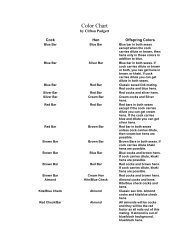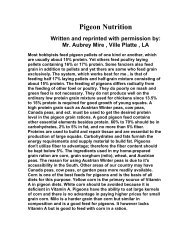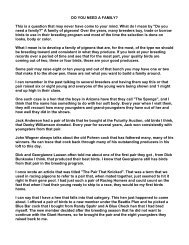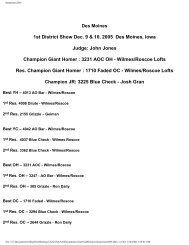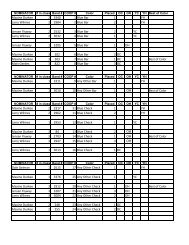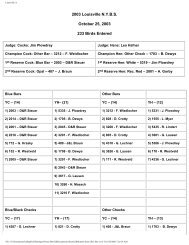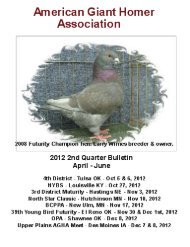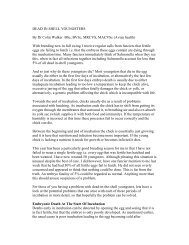Creation of the Giant Homer - American Giant Homer Association
Creation of the Giant Homer - American Giant Homer Association
Creation of the Giant Homer - American Giant Homer Association
You also want an ePaper? Increase the reach of your titles
YUMPU automatically turns print PDFs into web optimized ePapers that Google loves.
The pioneers in <strong>the</strong> creation <strong>of</strong> <strong>the</strong> <strong>Giant</strong> <strong>Homer</strong> also became pioneers in <strong>the</strong> establishment <strong>of</strong> <strong>the</strong> <strong>Giant</strong><strong>Homer</strong> <strong>Association</strong>. R.W. Keene was <strong>the</strong> first Charter President, C.F. Hober became Vice President, andWm. P. Gray became Secretary-Treasurer.Between 1918 and 1928 many pigeon breeders were trying to develop bigger and better <strong>Homer</strong>s --- asduring those early years <strong>the</strong> squab was a most popular table delicacy and pr<strong>of</strong>itable economic product.The early Squabbing <strong>Homer</strong> was not always known as <strong>the</strong> “<strong>Giant</strong> <strong>Homer</strong>”. In 1919 and 1920, <strong>the</strong> WilsonPigeon Farm, in Wilson, Kansas, called <strong>the</strong>ir best squabbers, <strong>the</strong> <strong>Homer</strong>, just a “Squab-breedingpigeon.” In 1921, <strong>the</strong> Quality Pigeon L<strong>of</strong>ts, in Marinette, Wisconsin, called <strong>the</strong> Squabbing <strong>Homer</strong> <strong>the</strong>“Classy Flying Utility Bird.” Also in 1921, <strong>the</strong> Marksacre Pigeon L<strong>of</strong>ts were selling <strong>Homer</strong>s as “SquabBreeders” and “Exhibition Birds.” W.C. Osterwisch, in New Memphis, Illinois, was selling “SquabBreeding <strong>Homer</strong>s.” At <strong>the</strong> same time, in Butler, Pennsylvania, <strong>the</strong> Ideal Squab Company Inc. wasstarting to produce a larger squabbling <strong>Homer</strong> cross. So here in 1021 we can mark <strong>the</strong> beginning <strong>of</strong> acompletely new movement in developing larger utility squab breeders ---Cross-Breeding.Beginning slowly after 1918 --- picking up momentum in 1921 --- many squab producers were raisingflying, working Racing <strong>Homer</strong>s along with one or more breeds <strong>of</strong> <strong>the</strong> “BIG SIX” utility group --- tryingto combine <strong>the</strong> prolific production ability <strong>of</strong> <strong>the</strong> Working <strong>Homer</strong> with <strong>the</strong> larger size <strong>of</strong> <strong>the</strong> “BIG SIX”utility breeds. The “BIG SIX” utility group consisted <strong>of</strong> Hungarians, Runts, Maltese, Carneaux, WhiteKings, and Registered White Swiss Mondaines. The <strong>Homer</strong> breeders were seriously beginning to use<strong>the</strong>se “BIG SIX” breeds solely as tools to make <strong>the</strong>ir <strong>Giant</strong> <strong>Homer</strong>s bigger and more prolific producers <strong>of</strong>heavier squabs.It is general scientific knowledge that “Hybridization” <strong>of</strong> compatible breeds <strong>of</strong> plants and animalsincreases <strong>the</strong> capacity for improved production. In 1920, <strong>the</strong> Cedar Lawn Poultry Farm, in Morristown,New Jersey, were raising White Swiss Mondaines, Carneaux, and Working <strong>Homer</strong>s toge<strong>the</strong>r --- crossbreeding.H.N. Webb, <strong>of</strong> Springfield, Missouri, was also crossing <strong>Homer</strong>s with Carneaux andMondaines. L.N. Simons, <strong>of</strong> Philadelphia, Pennsylvania, was crossing Carneaux and Working <strong>Homer</strong>s. Itwas here during <strong>the</strong>se years <strong>of</strong> <strong>the</strong> flourishing squab industry that <strong>the</strong> flying <strong>Homer</strong>s became known as th“Working <strong>Homer</strong>”, --- and it was out <strong>of</strong> <strong>the</strong> “Working <strong>Homer</strong>” concept that <strong>the</strong> new idea <strong>of</strong> <strong>the</strong> “<strong>Giant</strong><strong>Homer</strong>” came forth.In 1922, a new “twist” entered into <strong>the</strong> objectives <strong>of</strong> <strong>the</strong> “Cross-Breeders”. The Dalton Pigeon L<strong>of</strong>ts, <strong>of</strong>Joplin, Missouri, was still crossing Working <strong>Homer</strong>s with Carneaux and White Kings with a newobjective. Floyd Baker, <strong>of</strong> Hereford, South Dakota, also had this “New Vision” in his crossing <strong>of</strong> Runts,Carneaux, and Working <strong>Homer</strong>s. These Breeders, and many o<strong>the</strong>rs like <strong>the</strong>m, were, <strong>of</strong> course, interestedin developing <strong>the</strong> <strong>Homer</strong> as a “Super Squab Producer”, but, with o<strong>the</strong>rs, were also beginning to develop<strong>the</strong>ir “Prize Birds” as Show Birds and Squab Producers. Here --- <strong>the</strong> <strong>Giant</strong> <strong>Homer</strong> began to emerge as aDual Purpose Bird.As <strong>the</strong> satisfaction <strong>of</strong> competition began to outweigh <strong>the</strong> dwindling pr<strong>of</strong>its <strong>of</strong> selling squabs, <strong>the</strong> <strong>Homer</strong>slowly became more and more a popular Showbird. The squabbling industry lost popularity because <strong>of</strong>rising production costs and shipping fees which produced lower and lower pr<strong>of</strong>it margins. Keep in mindnow that this article is dealing with <strong>the</strong> history <strong>of</strong> <strong>the</strong> <strong>American</strong> <strong>Giant</strong> <strong>Homer</strong> as it originated in 1918 ---and how it developed up to 1928 when <strong>the</strong> “<strong>American</strong>” <strong>Giant</strong> <strong>Homer</strong> <strong>Association</strong> was organized.Following 1928 --- new efforts to build <strong>the</strong> <strong>Giant</strong> <strong>Homer</strong> into a more beautiful Showbird by crossing itwith o<strong>the</strong>r breeds were begun changed. These efforts following 1928 will be dealt with in fur<strong>the</strong>r chapters<strong>of</strong> A.G.H.A. history.



